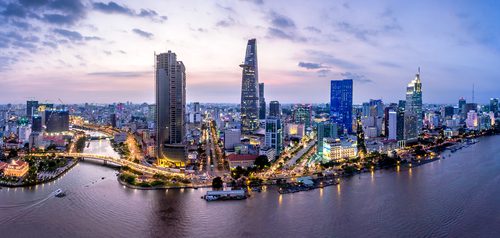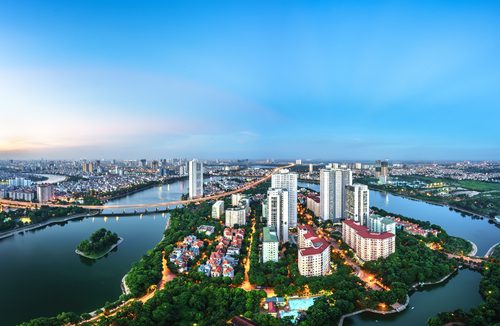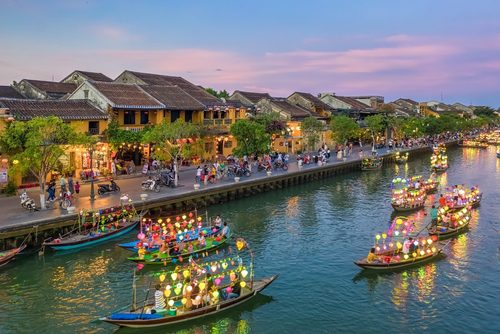Vietnam is a long, thin nation wedged between the borders of Laos and Cambodia, the South China Sea, and features a variety of spectacular scenery, from the north’s verdant rice terraces and mountainous forests to the south’s rich delta and stunning beaches. Vietnam has seen its share of difficulties. Vietnam was ruled for over a thousand years by several Chinese dynasties until 938 AD, at which point it became a French protectorate.
After the war for independence came the Vietnam War. You can see why Vietnam is a proud nation today. Not just for vehemently upholding its own independence, but also for its breathtaking scenery and fascinating past, offering a myriad of Vietnam places to visit.
You can reach Vietnam by various modes.
By air: The Nội Bài International Airport is situated in Hanoi. It is the capital of Vietnam. From this city, you can easily travel to other places.
By train: Air-conditioned trains link Hanoi, Hué, Danang, Nha Trang, and Saigon (Ho Chi Minh City). Hoi An is just 30km by bus or taxi from Danang.
By road: After reaching Hanoi by air, you can travel to different cities by road.
8 Vietnam tourist places you must visit
Halong Bay
One of Vietnam’s greatest tourist destinations, Halong Bay, with its breathtaking blend of karst limestone hills and protected, glistening waters. But there is plenty of breathtaking landscape to go around with more than 2000 islands. Make time for your own personal moments on this World Heritage marvel by booking an overnight cruise, waking up early for an ethereal foggy morning, or paddling a kayak through grottoes and lagoons.
Would you prefer a less cluttered karst landscape? Try Bai Tu Long, the Vietnamese place to visit, which lies in the north, or Lan Ha Bay, which is less visited but nonetheless stunning and is a bit to the south.
The distance from Noi Bai International Airport to Hanoi is 30 kilometres (19 kilometres). The largest and closest international airport near Halong Bay is located here. The majority of tourists will spend one day seeing the city before leaving for Halong Bay the following day.
Entry fee: VND290,000

Phong Nha-Ke Bang National Park
Hang Son Doong, one of the biggest caverns in the world and the main natural wonder of Vietnam, is situated right in the middle of Phong Nha-Ke Bang National Park. However, unless you have a cool 2 lakhs to spend on a tour, you won’t be able to explore this underground wonder.
Images of ant-like passengers flashing headlamps around the huge, empty caves pique the wanderlust. There are also additional caverns in Phong Nha-Ke Bang, including Hang En, which has its own beach, that you may explore for far less money by climbing, crawling, boating, or ziplining. There are also many sights above ground, such as guided hikes through the oldest karst mountains in Asia, which are home to tigers, elephants, and 300 species of birds.
There are regular flights to Phong Nha from Dong Hoi Airport. There are weekly flights to Phong Nha from Chiang Mai, Thailand.
Timings: 7:00 a.m. to 4:00 p.m.
Entry fees: Nil

Ho Chi Minh City
Former Saigon has a visceral vitality that will please fans of major cities despite being increasingly multinational yet still distinctly Vietnamese. You’ll either be dragged into its exhilarating vortex and be fascinated by the constant hum of its orbiting motorcycles, or you’ll find the entire experience overpowering. HCMC doesn’t encourage objectivity (and some visitors seem to be perpetually seesawing between the two).
If you plunge in, you’ll be rewarded with a richness of history (the War Remnants Museum is a must-see), delectable cuisine, and a lively nightlife that includes everything from beers on street corners to upscale cocktail bars. In Saigon, the heat is constantly on, so let your collar down and take it all in.
You can reach this city by air at the Tan Son Nhat International Airport.

Phu Quoc
Phu Quoc, located in the far south of Vietnam, is the perfect place to slow down, grab a cocktail, and toast a copper sun as it drops into the water. It is lapped by turquoise waters and bordered by the type of white-sand beaches that make sunbathers weak at the knees.
The island is relatively small and offers areas of natural, untainted jungle alongside some newer, less-serene additions (a Vietnamese version of Disneyland and the world’s longest over-sea cable car, as two examples). And if you want to kick things up a notch, grab a bike and hit the red-dirt roads.
You can reach this city by air at the Phu Quoc International Airport.

Hanoi
The capital of Vietnam is a city that has one foot firmly planted in a fascinating history and one foot confidently moving forward. Explore the Old Quarter’s streets while drinking egg coffee (coffee made with egg yolks) or chowing down on a hefty bowl of bun rieu cua (sour crab noodle soup), all the while observing business people eating noodle breakfasts or playing chess with goateed grandfathers.
When you’re finished, explore the French Quarter’s decaying decadence before heading to the fashionable Tay Ho for exquisite eating options and information on Hanoi’s developing art scene.
You can reach this city by air to the International Airport in Nî Bài. Hanoi is home to this airport. It is Vietnam’s capital. You can reach other locations quickly from this city.

Hoi An
Vietnam’s most atmospheric and endearing town is the historic Hoi An. It has the majestic architecture and alluring riverbank location, befitting its past as a significant port. Although, of course, people and rice fields have been gradually supplanted by tourist enterprises, the Old Town’s remarkable legacy of teetering Japanese merchant homes, complex Chinese guildhalls, and antique tea warehouses has been preserved on the exterior.
The atmosphere includes a lot of lounge bars, boutique hotels, travel agencies, a tonne of tailor shops, and a tonne of everyday travellers. Get on a bike and explore the town’s lovely environs if it all becomes too much; you’ll discover that life there moves at a far more leisurely pace.
Hoi An, Vietnam, does not currently have an airport. Fly to Da Nang International Airport, which is the closest airport to Hoi An, Vietnam, or Chu Lai Airport, which is 90 kilometres distant, if you wish to get to Hoi An City by air.

Ba Be National Park
The Ba Be National Park, a must-visit location for adventurers, is a detour from the typical Vietnam tourist route. The surrounding panorama sweeps from limestone mountains with peaks up to 1554 metres down into deep valleys lined with lakes and waterfalls. In addition to the critically endangered Vietnamese salamander, the park is home to hundreds of other animal species, such as monkeys, bears, and pangolins (the only mammals with an entirely scale-covered body).
For bird watchers, the park is a haven for the magnificent crested serpent eagle and the oriental honey buzzard, which can be spotted on boat trips or trekking expeditions. Recharge at the rustic homestays and village guesthouses of the local Tay ethnic group after a day of animal spotting.
You can reach Ba Be Tourism Centre from Hanoi through tourist shuttles. You can also take local buses or board minivans from My Dinh bus station in Hanoi.
Timings: 9:30 AM – 5:00 PM.
Entry fee: VND15,000-VND20,000

Nha Trang
The blue bay is lined with tropical islands, and the high-rise, high-energy beach resort of Nha Trang is surrounded by a necklace of hills. The beachfront is defined by a long, white-sand crescent beach, and it is flanked by a grand promenade lined with sculpture gardens and parks.
While there are many international shops and restaurants in the interior, the nightlife in central Nha Trang really comes to life when restaurant service winds down for the day. Looking for a calmer atmosphere? Additionally, the city serves as a fantastic starting point for a beach crawl up the coast to Quy Nhon, including stops at Doc Let, Bai Bau, and Bai Xep.
You can fly to this city to the Nha Trang (Cam Ranh International Airport) is the main airport serving the Nha Trang area. The airport is located in Cam Ranh, a town in Khanh Hoa.

FAQs
Is Vietnam affordable for travellers?
Vietnam is a developing country, with relatively inexpensive travel expenses. The prices are comparable to those in Thailand and other close-by nations. However, the cost of lodging is a little expensive. The price will vary depending on the kind of accommodation, the number of days you want to stay, and the cuisine you intend to eat.
How long is necessary to tour Vietnam fully?
A visitor to Vietnam should have at least two weeks available to see the main attractions and interesting locations; three weeks should be plenty. For one to see the four most well-known Vietnamese locations—Ho Chi Minh City, Hanoi, Halong Bay, and Hoi An—ten days is the very least amount of time that they should plan on.
Which month is ideal for travel to Vietnam?
The spring season, which runs from March to April, is rather nice since the weather is warm and bright, in contrast to the summer months, which run from May to August, which are generally hot and humid.
Is it ok to travel to Vietnam?
Vietnam is a relatively safe country to visit since people follow the laws and regulations pretty strictly. Although frauds and problems still exist in Hanoi, HCMC, and Nha Trang, the authorities in this country maintain a tight grip, and there are hardly any incidents of theft and robbery nationwide.






